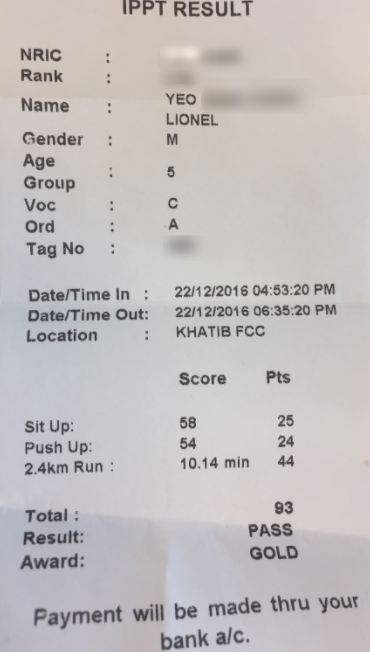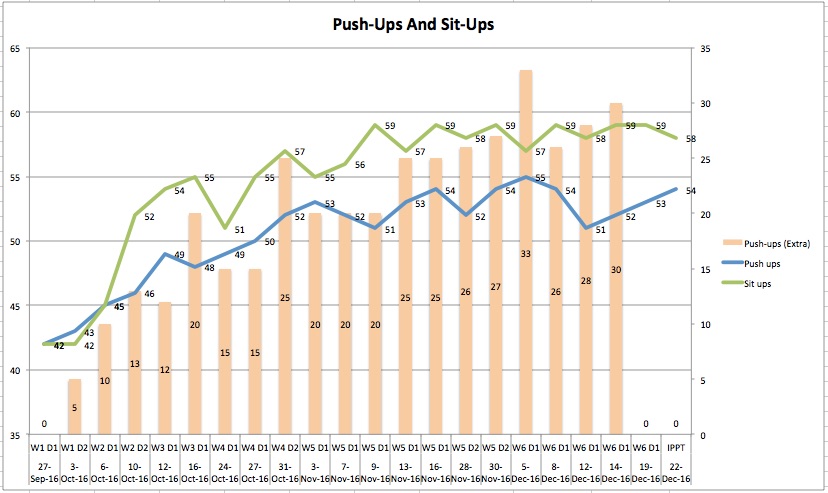While trying on T-shirts at Uniqlo, I realised that not a single M-sized shirt could hide my proudly protruding belly. Aren’t these changing room mirrors supposed to make you look more attractive than you actually are? Ugh.
It was time to do something about it.
I didn’t want to do the usual “join a gym, pay lots of money, fall of the treadmill (literally)” cycle that plagues so many people today. No. If I wanted to overcome this belly-crisis, I needed something concrete. Something motivating. Something like… Getting an IPPT Gold.
Ah, IPPT: The Bane of NS Men everywhere. The annual rite of passage that involves us panicking right before our “window” closes and barely passing our hastily-scheduled test. We breathe a sigh of relief, only to have the horror repeat itself year after year.
Thankfully, I’d always been able to pass without much trouble, but getting that elusive Gold seemed like a sufficiently motivating benchmark for my new “Stop being a couch potato” lifestyle. There were 3 reasons:
- Monetary: An IPPT Gold comes with a monetary incentive of $500 (thanks, taxpayers!). Sure, $300 for a Silver was nice, but I’d probably blow it all on an expensive, forgettable dinner. $500, on the other hand, was some serious cash. It could pay for a long weekend in Bali, a new iPhone, or capital to start a new business.
- Psychology: Something funny happens when you turn 31: All your friends start making old and fat jokes like “my six-pack is hiding under my one-pack”, or “My exercise for the day is walking up the escalator”. I’m guilty of it myself, but I also know that this kind of talk is a self-fulfilling prophecy. I needed tangible proof to rekindle my belief that my age was just a number.
- Learning: As you can tell from my blogposts, I’ve been getting really interested in the concept of deliberate practice and skill mastery. What would happen if I applied the principles I learnt to my own physical fitness? IPPT gave me the perfect opportunity to test it out – it was an objective, measurable, goal that I could pit myself against.
At this point, I should also mention that my version of “Gold” is a lot stricter than the general populace. You see, I was trained as a Commando (I know I totally don’t look like it now), and the tradeoff for earning a red beret as an NSF meant that I had to suffer tougher IPPT standards as an NS Man. Specifically, while most people need just 85 points to hit Gold, I had to jump through a higher hurdle of 90 points.
Anything less – even if I had gotten 89 points – meant that I would be pushed down into the mediocrity of Silver. As the PTI who conducted the test briefing said, “If you are Commando, Guards, NDU, sorry – you are just suay.” Gotta love the pre-test pep talk.
We-ell, to cut a long story short, I did it. I trained for 3 months, tracked my progress, and got my IPPT Gold and $500 in extra cash last week:
Today, I’m gonna open the kimono (not literally, don’t worry) and walk you through my exact training regime and the test tactics I used to get those results.
If get an IPPT Gold seems like a worthwhile 2017 resolution to you, I hope this helps you out. If I could go from couch potato to Commando Gold in 3 months, so can you.
As usual, this is just my own experience. Make sure you consult a doctor first, train safely and reasonably, please don’t die, all that good stuff. Now, let’s get to it:
A Brief Primer On IPPT
(For those of y’all who’re already familiar with the test, feel free to skip this section and head straight to “Training Regime”.)
The IPPT (Individual Physical Proficiency Test) comprises 3 stations:
- Push ups (out of 25 points)
- Sit ups (out of 25 points)
- 2.4km run (out of 50 points)
Push ups and Sit ups are scored based on how many reps you do within a 1-minute time limit. Your 2.4 km score depends on how long you take to run 2.4 km (or the equivalent of 6 rounds around a standard track). Points get adjusted depending on your age, i.e. the older you are, the fewer reps you have to do to get a given score. You can see the full scoring tables and standards here.
Whether you get a Pass, Silver or Gold depends on how many total points you get out of 100. What this means is that unlike the previous version of IPPT, the new test is a lot more flexible. For example, if you’re weak in Push ups, you can always make up for it by running faster (and getting more points) during the 2.4 km run.
Training Regime
To train for this year’s IPPT, I used Goody Feed’s IPPT training guide that breaks down what you have to do on a week-by-week basis. Yes, it claims that you can “Pass” within 2 months, although it took me longer because I repeated sessions (more on that later).
Schedule
Set aside two days a week, for about 1 hour each, to train.
You can probably do it in less time if you wanted, but I like to take my time warming up and resting between exercises. It’s important to make it an integral part of your schedule – a commitment that you’ll stick to week after week. For me, I set aside Monday and Wednesday evenings before dinner, which eventually became a habit.
Venue and Equipment
You’ll need a fitness corner with a sit-up bench, and a known 2.4km running route.
Personally, I started training at a fitness corner which had a tiny track encircling a mini-field. I later moved to a full-fledged stadium with a track to more accurately track my 2.4 km timing. You’ll also need a cheap wristwatch, running attire, and a water bottle.
Your Baseline
On your first session, start by doing your max reps for Push-Ups (PU), Sit-Ups (SU) and run your fastest timing for your 2.4km run.
Make sure that you do all 3 stations according to the proper IPPT form (see the correct form for push-ups here). This is especially important for Push-Ups and Sit-Ups, because the PTIs are really strict and will no-count you if you perform a “sub-standard” rep. So make sure that you create good habits from the start, so that it becomes effortless on the actual day.
- PU: Chest all the way down (I found that making my chin touch the floor was a good proxy), no arching your back, no “wriggling” as you struggle to get up, etc.
- SU: Hands cupping ears, elbows touching knees, shoulder blades touching the floor, etc (I found that as long as I open up my elbows and touched the floor with them, that virtually ensures that my shoulder blades would hit the ground as well)
Time everything using your stopwatch or your phone. Set it for one minute, and do as many reps as you can within the time limit.
I’ll just say it off the bat – you’ll suck at your first session. That’s okay. The whole point is to get your baseline performance so that you can track your progress going forward.
For the next session onwards, follow the Goody Feed training recommendations and try to hit the targets for each day.
Tracking Your Progress
Record your progress in a spreadsheet, like this:
You can download a template spreadsheet here.
Whenever I couldn’t hit the prescribed targets for that day (for example: PU+8 in Week 4 Day 1), I would simply repeat that day in the subsequent sessions until I could hit the targets.
While this wasn’t explicitly stated in the Goody Feed article, I found that it was really useful to help me build my foundation. It also gave me a single number to hit (e.g. “50 push-ups, Lionel, you just have to hit 50”), knowing that I had already achieved all previous targets prior to that.
Push-Ups And Sit-Ups
Goody Feed recommends training for Push-Ups and Sit-Ups in 2 parts:
- Doing the actual reps under “test conditions”, i.e. 1 minute
- Doing additional reps with no time limit until you can’t do any more
That means aiming to do, say 30 Push Ups in 1 minute today. After that, have some rest, take a stretch, and then do more push ups until you can’t do any additional reps without compromising on proper form.
This is especially useful because the main constraint for these stations isn’t your raw strength – it’s the time limit.
Given enough time, I could easily hit 50+ push-ups at one go if I could “rest” between reps. However, limiting my Push Ups / Sit Ups to just 1 minute means that I didn’t have the opportunity to push my muscles beyond their limits.
That’s where the additional reps come in: They helped me to do my true maximum without having to worry about the time limit.
In other words, the initial 1-minute burst is to gauge your performance; while the additional reps are where you really improve. Even though the Goody Feed article doesn’t prescribe additional reps for Sit Ups, I’d still recommend doing them if you’re weak in that area.
Another thing: If you’re already hitting the maximum reps for a full 25 points at either station, try to hit 3-4 additional reps within the time limit. This will help to make up for no-counts during the actual test.
For example, I was hitting the maximum Sit-Up target (56) by my 9th training session. I then focused on squeezing in an additional 2-3 reps within the time limit, to allow for any no-counts during the test day.
Here’s a chart of my progress:
A couple of observations:
- There are ups, downs and plateaus. You won’t always see improvements in every session, and that’s ok. It’s normal for your performance to vary within such a short time frame. (Just like how randomness affects intraday traders a lot more than buy-and-hold investors)
- A lower score doesn’t translate to poorer performance. For example, on 16 Oct, I did one less Push-Up under test conditions but also improved my additional rep count by 8 over the previous session. It indicated that I was getting stronger even though it didn’t translate into more reps under test conditions.
The 2.4 KM Run
The first 4 weeks of training will just have you running 2.4km to your best ability – pretty straightforward. Yeah, it’ll feel like crap when you do it, but it’s also one of the easiest areas to see quick improvements. For example,I ran 11:55 on my second session, but improved by 45 seconds to hit 11:10 by my third session (see the chart below).
2.4 km is all about pacing yourself. From my experience, I performed a lot better if I maintained the same time for each lap, as opposed to running really fast for the 1st round and feeling exhausted for the subsequent 5 rounds. Some runners I know like to jog slower for the first few rounds and spring in the last few, but that seems way too risky to me.
Personally, I try to hit a steady 1:45 to 1:50 for each round, which would give me a decent time of 10 min 30 secs for the entire run. Keep a close look at your stopwatch as you complete each lap – that will give you a clue about whether you’re going too fast or too slow, so you can adjust accordingly.
Here’s another hack that I found useful: Run on the 3rd lane. This makes the run a little tougher because you need to cover an extra few metres for each round. It’s the equivalent of wearing weights around your ankles when you do pull-ups. Once your body is used to the difficulty, you’ll rocket through each round during the actual test day.
Interval Training
By Week 3, you’ll start to do 30-second intervals (sprint for 30 seconds, rest for one minute, and do it again) which are known to be deadly effective at improving your stamina.
Since it was hard for me to gauge 30 seconds while sprinting, I opted to sprint for 200m instead and record my timing for those. I ended up taking about 40-45 seconds on average for each 200m interval.
When you sprint, make sure that you’re going full out. I’m talking breath-panting, legs-feeling-weak, almost-feel-like-dying kind of a full out. It’s important, because that’s the only way that you’ll train your body to improve the flow of oxygen to your legs.
Interval training – on its own – isn’t that tough once you get used to it. The REAL challenge comes from Week 5 onwards, when you have to run a full 2.4km (full out), followed by interval training (extra full out).
This is EXTREMELY challenging, and there were times when I felt like giving up or copping out (like say, do 4 intervals instead of 6). Don’t compromise. If you need to, sprint slower (if there is such a thing), but complete the entire interval set. Psychologically, your mind will tell your body that “since you did 6 intervals last time, you can do it again today”.
Here’s what my 2.4km performance looked like:
The gaps correspond to the days when I did interval training without running 2.4km. You’ll notice a couple of things:
- I didn’t skip days: The spikes on 7 Nov and 12 Dec correspond to days when I felt sick/lethargic. On those days, I didn’t push myself, but instead took a slower, leisurely run to maintain the momentum. Surprisingly, I’d often feel much better after running on those days as well. Of course, make sure you do this only if it’s safe – make your own judgment about how your body feels.
- Initial gains come quickly: The first 2 sessions saw very big improvements, which underscored how quickly I could get initial gains to my “normal” standard of fitness. Also, because I didn’t skip any training days, I could very quickly return to my usual timing after taking it easy during the previous session.
- My performance was relatively flat: After the first 2 sessions, my time fluctuated within a narrow band of 11:10 and 10:50. This was puzzling to me, because no matter how hard I pushed myself, I just couldn’t push past the magical 10:50 barrier during my training. I’m pretty sure this doesn’t apply to everyone though – sustained training should help you to see improvements. Still, towards the tail end of my training I was already feeling much fitter and faster compared to when I first started, even though it didn’t show up in my timing.
Test Day!
To be honest, I wasn’t 100% sure that I could get a Gold when I went for the test. I still had 2 more weeks in the Goody Feed training programme to go, and based on my training I had only just barely clinched a Gold.
Still, it was the end of the year and I wanted an accurate gauge of my performance under test conditions. Based on past experience, I also knew that I would likely perform much better during the actual test than during my training (which I dub the “IPPT Performance Enhancing Phenomenon”). I’m not sure why that is – maybe it’s adrenaline, competition, or just my frame of mind.
Here are a couple of tips, based on my own experience taking the test for 3 years at Khatib FCC:
Registration
Don’t be the first few to register. The first few registrants tend to be called for the test first, which means you don’t have time to prepare yourself mentally. Instead, you’d want to be the 40th – 100th registrant, which would put you into the 4th – 10th detail. That gives you enough time to observe the first few details, visualise your own test, and pump yourself up.
However, make sure that you’re also not the last few to register, as that means you would have to wait for a loooong time before your turn, which would negate the effect of any prior warm-ups. In general, I like registering for the test around 10-15 minutes before the official start time.
Pre-Test Preparation
Lock everything away into the lockers – coins, phones, chains, watches, etc. You won’t need them – not even your stopwatch. Go to the bathroom. Do some stretches because the standard SAF “warm-up” isn’t quite good enough. Drink some water about 5 minutes before the briefing starts so you’re hydrated without the risk of getting a stitch.
Push-Ups
The test starts with you in push-up position, with your chest on the floor. Your assistant will be in prone position, perpendicular to you.
At this point, get your assistant to place his fist on the ground, and do a couple of test push-ups. This is the first time you’re doing push ups with an assistant, so it’s important that you gauge how it feels. Make sure that your hands are placed no wider than shoulder-width apart.
The flooring is also important – I didn’t realise how different it felt to do push-ups on a tiled floor, as opposed to a rubberised fitness corner floor. So get used to those sensations with 1-2 test push-ups.
Push-Ups is the strictest IPPT station, so be sure to keep proper form as you’re doing them. If you need to rest with your butt sticking out, be sure to return to a flat back before continuing your reps.
Sit-Ups
Get your assistant to test the grip on your shoes and ankles. I tend to rocket off like a wild horse while doing my sit-ups, so it’s important that my assistant knows exactly how much pressure to apply. Similarly, do a couple of test sit-ups to test out the sensation.
2.4 km Run
Once you’re done with Push-Up and Sit-Ups, calculate your score and see what 2.4 km timing you need to achieve to get a Gold. This is it. This is the one number that you need to strive for. Everything else is irrelevant.
The FCC has a wonderful ERP-like system that tracks your time. As you run under it, it lets out a cheerful beep and flashes your time on an electronic display board nearby. That’s why you don’t need to wear a watch – just take a quick glance at the board and you can gauge if you’re maintaining the pace you need.
Here’s my strategy for the 2.4km test:
- Line up towards the back of your detail (you don’t need to at the same time as everybody else because the ERP system thingy will only start timing you when you cross the start line). This gives you a nice pool of people to overtake in the first few rounds, which is psychologically powerful.
- For the first round, everyone is going to start running really fast. Resist the temptation to zoom off the start line because that is the surest way to burn out. Also, your legs haven’t properly warmed up yet so this isn’t an ideal time to sprint. Instead, maintain a steady pace and focus on overtaking the first 4-5 runners in the first round. You should come in about 3-5 seconds faster than your usual training time – that’s how you know you’re pacing yourself correctly.
- For all subsequent rounds, focus on the “Overtake The Next Person” Strategy by always striving to overtake the person in front of you. This is the easiest way to ensure that you’re constantly pushing yourself.
- In the final (6th) round, start opening up your pace and running faster from the first 100m, even though your body will be screaming in protest. You should be sprinting all out in the final 100m with every last ounce of energy you have.
If you’ve trained and paced yourself correctly, you should emerge from the test with a much better timing than what you got during training. Personally, I managed to hit 10:14 this year, which isn’t that amazing but still 42 seconds faster than my last training time.
Finally, take a slow walk back to the FCC, savoring the sweetness of victory. Get your results slip, smile to yourself, and grab a nice meal to celebrate.
Lessons Learnt
A couple of final lessons I learnt from this year’s IPPT episode:
- Track your performance: Whatever gets measured gets managed. There’s nothing more motivating than seeing – in a tangible way – your performance in numbers. Even if you hit a plateau like I did, the very act of recording your numbers flips a switch in your mind to push yourself to do better the next time.
- Training is supposed to be hard: Everybody wants to have a billion dollars, a 6-pack of abs, or an IPPT Gold, but few are willing to put in the sacrifice to do it. Nobody sees the sweat, the exhaustion, and the disappointments during training. It’s supposed to be like that – anticipate it, and push through it.
- Take the plunge even if you’re not sure: I took the test even though I felt like I only had about a 70% chance of getting that Gold. But thanks to the IPPT Performance Enhancement Phenomenon, I always surprise myself on the test day. So schedule a test even if you’re not 100% prepared. At the very minimum, you’ll gain one more training session and get valuable feedback. Besides, you can take the test as many times as you like – what have you got to lose?
Annnnnnnddd – that’s it! My entire IPPT training philosophy and regime, laid out for you. I hope you find it useful, especially if you’re gunning for more fitness in 2017.
This is only the beginning. If you can get an IPPT Gold today – something which you thought was previously impossible – what else you can accomplish tomorrow?





Inspiring read!
congrats on the gold!
did the new 3-station test this year.. and the PU was extremely strict!
very detailed,motivating and also inspring.i will give it my best shot 🙂